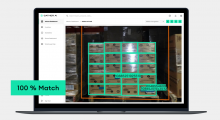What a year. The COVID-19 pandemic set in and made a massive impact on global trade and amplified existing logistics challenges around the world; lockdowns triggered rapid growth in e-commerce, putting additional strain on already strained freight networks; and a last-minute Brexit deal was finally reached following a few chaotic weeks at the UK border.
While all of these challenges remain, 2021 also brings hope, especially because distribution of vaccines has started worldwide—with strong support from the logistics industry. “Safely delivering COVID-19 vaccines will be the mission of the century for the global air cargo industry, but it won’t happen without careful advance planning,” says chief executive Alexandre de Juniac of the International Air Transport Association (IATA).
Based on a calculation in 2020, IATA estimates that around 8 billion doses will be necessary for a first vaccination of the entire global population—a freight volume that would require 8,000 Boeing 747s. Qualified refrigerated facilities across a global network of locations where the vaccines will be stored are also now an absolute necessity.
The vaccines must be handled and transported at controlled temperatures and protected from tampering and theft. Now that the first vaccines have been authorized and the first countries have started their vaccinations, the air cargo industry and their network partners have proved that they are well prepared for what has been called the biggest mission in industry has ever seen.
Global air cargo collaboration
To cope with this challenge, special taskforces have been established. In Asia, the Changi Ready Taskforce has been set up at Singapore’s airport, co-led by the Civil Aviation Authority of Singapore (CAAS) and Changi Airport Group (CAG) for the transportation and distribution of COVID-19 vaccines.
Comprising 18 members from across the Changi air cargo community, the taskforce is a public-private collaboration involving government agencies, cargo handlers, airlines and freight forwarders. Changi Airport is a preferred pharmaceutical air cargo hub in the region. As the first and largest IATA CEIV Pharma certified community in the Asia Pacific region, with at least one member in each node of the air cargo supply chain, the Changi air cargo hub offers an unbroken cold chain necessary for the effective handling of temperature-sensitive pharmaceutical shipments.
The taskforce has been set up to prepare the air cargo community to meet the logistical demands of vaccine distribution. This includes assessing and ramping the hub’s ability to handle different types of COVID-19 vaccines, all within stringent temperature-controlled environments, as well as to manage an expected surge in the volume of vaccines to be air transported to the region.
In December, Singapore Airlines (SIA) delivered the first shipment of Pfizer-BioNTech vaccines to CAG on board one of its Boeing 747-400 freighters. This was also the first Pfizer-BioNTech vaccine shipment to be delivered in Asia.
“The delivery of this first batch of COVID-19 vaccines to Singapore is an important milestone in the fight against COVID-19, and we are honored to be able to play a part in this,” says Chin Yau Seng, senior vice president of Cargo for SIA. “It also served to demonstrate SIA’s and the Singapore air hub’s readiness for the very important job of transporting and distributing COVID-19 vaccines internationally.”
In Europe, Air France KLM Martinair Cargo has constructed a new climate cool room at its Schiphol Pharma Hub in Amsterdam with temperatures ranging from +2 °C to +8 °C, and capacity required to handle COVID-19 vaccines. Air France KLM Martinair Cargo is a member of the taskforce Vaccines Gateway Netherlands, where sixty companies are working together at Amsterdam’s Airport Schiphol to ensure the safe, secure, and swift transportation of the vaccines from manufacturer to end-user.
The controlled-temperature transport and distribution of COVID-19 vaccines is also a major challenge for the logistics integrators, who made investments into infrastructure and technology. UPS is building “freezer farms” in the Netherlands and in the United States featuring banks of -80 °C freezers. The farms will contain around 600 freezers that can each hold 48,000 vials of vaccine.
Additional freezer capacity will be also installed in Germany, the UK, and South America. In the United States, DHL Global Forwarding has opened a 20,000-square-foot facility in Indianapolis, which is dedicated to life sciences and healthcare logistics. The facility offers temperature-controlled storage at 15°C to 25°C, 2°C to 8°C and -20 °C temperatures, and is located within a Free Trade Zone, thus allowing international cross shipping.
With its recently launched SenseAware ID, FedEx is offering the latest sensor-based proprietary technology. The company says it provides enhanced package visibility for shipments using a compact sensor that transmits its location every two seconds. FedEx intends to deploy this innovation as a critical safe feature to the anticipated vaccine distribution efforts.
“We believe the most critical attributes needed to tackle the size and scale of this monumental supply chain initiative are visibility, extensive temperature control, and intervention capabilities,” said Brie Carere, executive vice president, chief marketing and communications officer at FedEx.
Cool boxes
Among the winners of the pandemic are also the leading manufacturers of temperature-controlled container solutions. Companies like Envirotainer, CSafe Global and SkyCell see a strong global demand for their products and are expanding their networks.
Sweden-based Envirotainer, specialized in secure cold chain solutions for air transport of pharmaceuticals, plans to expand its network capacity for RAP e2 containers in the United States by 57%.
With four new RAP e2 stations in New York, Miami, Philadelphia, and Seattle, the company will increase the capacity to securely ship both COVID-19 vaccines and other medicines that require high-quality temperature-controlled solutions. Furthermore, it added Beijing to its network stations to support the rapidly growing pharmaceutical export market in China.
CSafe Global, a leading U.S. producer of cold containers, has expanded its global reach and local presence with a new hub operation in Taipei, Taiwan. This new addition to CSafe’s worldwide container operations facilities ensures Taiwan’s thriving biotech and pharmaceutical sectors have consistent and easy access to the cold chain industry’s top performing containers.
“We’ve been supplying containers to Taipei for some time now from our Hong Kong facility,” explains Tom Weir, chief operating officer for CSafe Global. “CSafe continues expanding its presence in Asia by investing in facilities to provide service to customers in their local area.”
Swiss-based SkyCell is attempting to address the challenges around the pandemic with an innovative container. The hybrid solution has two elements: It provides real-time insight into the condition of the payload (monitoring) as well as protection to prevent temperature excursions in the first place (the passive solution).
Global Logistics: New regulations underway
With the growing market dominance, the headwind against the big Internet giants is getting stronger. In 2020, antitrust investigations have been undertaken in the United States, Europe, and even in China.
In December, China launched an antitrust investigation into Alibaba as the State Administration for Market Regulation (SAMR) announced that it would probe alleged monopolistic behavior. SAMR is investigating the company’s practice of forcing merchants to sign agreements that prevent them from selling their products on competitor’s platforms.
Resistance is also increasing in Europe. On December 15, the European Commission announced a proposed package of digital markets legislation, the “Digital Services Act” (DSA) and the “Digital Markets Act” (DMA). The DSA aims at better regulation of major online platforms and includes measures to protect consumers from illegal content, increase transparency in terms of advertising, and reduce manipulation and disinformation.
The DMA is to enable the European Commission to prevent providers of “core platform services” such as marketplaces, search engines, or social networks from acting as “gatekeepers” and becoming too dominant and being able to determine the rules of the market themselves.
Gatekeeper status is presumed for companies with an annual turnover above €6.5 billion or a market value of at least €65 billion that operate a platform with more than 45 million monthly active end users and more than 10,000 yearly active business users.
DMA prevents unfair business practices, such as blocking users from uninstalling pre-installed software (like apps) and requires gatekeepers to enable greater interoperability between their platforms and third-party services. Before the proposals can be implemented, the EU states and the European Parliament must agree on a common legal text.
After many years of development, these two elements have been brought together in smart containers, which now present an effective way to transport vaccines and other biologics around the world. “The data derived from IoT-enabled containers can also be used to model journeys and conduct risk assessments for different routes before a shipment goes ahead,” says Richard Ettl, founder and CEO of SkyCell. “This improvement allows logistics companies to mitigate potential risks and reduce the financial and time costs associated with spoiled cargo.”
According to Ettl, the hybrid solution enables pharma companies to deliver their products door to door to the most challenging destinations worldwide. The design and technology have led to an audited spoilage performance of less than .01% rather than the previously accepted 4% to 12%, and IATA is moving closer to providing new standards for this type of container.
Parcel and e-commerce win
Despite COVID-19 lockdowns and the economic downturn, there are winners of the pandemic—the e-commerce market and its retailers, online platforms, and service providers.
According to the most recent Transport Intelligence (Ti) market survey, the global express and parcel market will be one of the big winners. In its forecast for 2020, Ti predicted a total value of €375.5 billion (+9.6% year-over-year). In the period 2020-2024, they expect that the market will grow at a CAGR of 7.5% and achieve a total value of €501.2 billion by 2024.
Regarding key regions and their domestic express markets, Ti forecasts that Asia Pacific will see an 11.1% CAGR between 2020-2014. With the booming express sector in China and other Asian key markets such as Korea and Japan, which came relatively well through the pandemic due to stringent lockdowns from the very start of 2020, the Asia Pacific region is expected to sustain a relatively more stable economic growth than other regions and to keep express growth moving at pace over the forecast period.
Europe’s Express market is set to grow faster than pre-pandemic expectations, with a predicted 2020-2024 CAGR of 5.4%. One reason is that Europe, and especially Germany, have undergone a significant push in terms of digitization through the crisis and are expected to maintain this pace.
The North American domestic express market is set for a post-COVID 2020-2024 CAGR of 5.4%, slightly down from pre-COVID estimates. The region’s biggest market, the United States, has implemented uneven stay-at-home measures across the country at state level, creating different shopping needs.
Indeed, the pandemic has accelerated e-commerce growth worldwide and caused a shift in the retail business. While local retailers suffered hard under the crisis, leading online marketplaces like Amazon and Alibaba were able to expand their market shares during the lockdown and increase online sales during Black Friday, Cyber Monday, and other e-commerce peak seasons around the globe.
China’s online giant, the Alibaba Group, generated a growth merchandise volume (GMV) of $74.1 billion during the 11-day “Global Shopping Festival” campaign in November, an increase of 26% compared to the same timeframe in 2019. In the meantime, Cainiao Network, the logistics arm of Alibaba Group, processed more than 2.32 billion delivery orders during the same period. Alibaba’s revenue for the third quarter was $22.8 billion, an increase of 30% year-over-year.
Amazon reported $96.1 billion in revenue during the third quarter of 2020, an increase of 37% compared to the same quarter in 2019. In order to cope with the growth, the company is continuing to expand its logistics network in Asia. Amazon announced plans to add 10 new fulfillment centers and expand seven existing sites in India as part of its global e-commerce strategy.
E-challenges facing brands
The e-commerce boom also offers opportunities for brands. According to a survey conducted by the logistics provider GEODIS and the consulting company Accenture Interactive, among 200 European and American companies in 2020, around 59% of the European and 46% of the American companies relied on marketplaces for their online sales. These marketplaces held a 28% market share in the pre-pandemic period—a number that has risen to 38% during the pandemic.
However, most of the brands surveyed believe that over-reliance on marketplaces is not sustainable and want to shift more toward owned e-commerce channels. Nearly two-thirds (64%) state that reducing their dependence on marketplaces is their first or second priority for the next six months.
“Direct sales from brands’ retail websites currently represent 5% to 8% of online sales. Brands would like to increase that to 20% or 30% in the next three to five years,” says Sohel Aziz, managing director of Accenture Interactive. “The survey shows that brands are aware of the fact that improving their omni-channel logistics capabilities is essential and urgent,” said Sohel Aziz, managing director, Accenture Interactive.
Among the big challenges is the lack of real-time visibility. According to the survey, only 16% of companies were able to get real-time key performance indicators for their supply chain, with 25% of American brands and 10% of European brands saying they had such visibility.
“Only a minority have real-time supply chain inventory visibility,” says, Ashwani Nath, global head of e-channel solutions at GEODIS. “However, this visibility is essential to ensuring product availability, offering a variety of shipping choices, and informing the customer of the product’s shipping status. Behind the scenes, this means optimizing the logistics cost for each order and overcoming many logistical challenges, such as reconciling the physical with the digital, maintaining a real-time inventory and managing transportation.”
The last-minute deal
Between pandemic worries and the e-commerce boom, another topic was in focus at the end of the year: the Brexit deal. After all the years, it was finally done and announced on December 24, 2020, with great relief from the British and European sides.
A hard break between Great Britain and the European Union as well as a chaotic no-deal Brexit situation was averted at the very last minute. The new free trade agreement (FTA) is now regulating trade relations between the UK and the EU as of January 1, 2021. The most important point is to avoid tariffs and to ensure smooth trading.
The business group Logistics UK and UK Warehousing Association (UKWA) welcomed the new FTA. “A deal is great news for the UK economy, since it removes the risk of tariffs being placed on almost every item imported from the EU, which would have raised prices and slowed the rate of economic growth,” says Elizabeth de Jong, the group’s policy director of Logistics UK. However, she also urges traders to continue to get ready for the new trading conditions and to be well prepared for the introduction of customs declarations and additional checks on food and livestock.
“The conclusion of a FTA is good news indeed and a better outcome than we might have expected given the impasse of recent days,” says Peter Ward, CEO of UKWA. “However, as usual, the devil is in the detail and, most importantly, the agreement doesn’t alter the fact that the UK is no longer in the Customs Union. So, export/import businesses will still need to prepare for the momentous changes ahead.”
The EU is the UK’s largest trading partner. In 2019, UK exports to the EU were £294 billion (43% of all UK exports). UK imports from the EU were £374 billion (52% of all UK imports).
Post-Brexit preparations
Despite the relief, trade between Great Britain and the EU states will be considerably more difficult than before. Companies on both sides will have to deal with more formalities.
Although the trade agreement does not impose any tariffs on British goods, British exporters to the EU have to prove that their products were actually mainly manufactured in their own country. Evidence of compliance with EU food safety rules and compliance with product standards will also have to be provided.
The British government has announced that it will initially wave through goods that come from the European Union for six months. Only gradually will papers have to be presented and controls take place.
Eurotunnel Le Shuttle Freight, operator of the railway shuttle service between France and the UK through the Channel Tunnel, is also delighted that a long period of uncertainty ends. As part of its ongoing Brexit preparations, it has launched the Eurotunnel Border Pass.
This new service will enable customers to upload all the data needed for their journey in a secure format to a virtual wallet, accessible during their crossing by Eurotunnel and the authorities of the two states.
In particular, it will enable the data needed for goods to cross the border to be transferred from haulers to Eurotunnel and then from Eurotunnel to the authorities in each country in a secure digital form, without truck drivers having to leave their vehicles or even present a document at the border crossing.
Brexit preparations are also underway in Europe’s leading seaport, Rotterdam. The port has adjusted its Portbase-IT system so that forwarders can report their ferry cargo digitally in advance. In December, the Port of Rotterdam Authority, Customs, Rijkswaterstaat, and Portbase started an information campaign and handed out “Get ready for Brexit” flyers to truck drivers carrying cargo to and from British ports.
The campaign was aimed at reminding drivers and their customers of the changes that they can expect in the Dutch ports as of 2021. Since the beginning of the year, customs documents need to be pre-announced digitally at the short-sea and ferry terminals through Portbase’s Port Community System. This procedure applies to all ferry and short-sea terminals. The aim is to ensure that freight continues to pass smoothly through Dutch ports.
Author Note: Every crisis is also an opportunity. It opens the door for something new. Many companies across Europe and the world are currently showing this in an impressive way. In just a short time, new web shops were launched, innovative products developed, and global collaborations started.
This is entrepreneurship at its best. During the crisis, the logistics industry and its service providers around the world have demonstrated how flexible and systemically relevant they are to keep the global supply flowing even in uncertain times. That can make us all optimistic.
Article topics
Email Sign Up
















